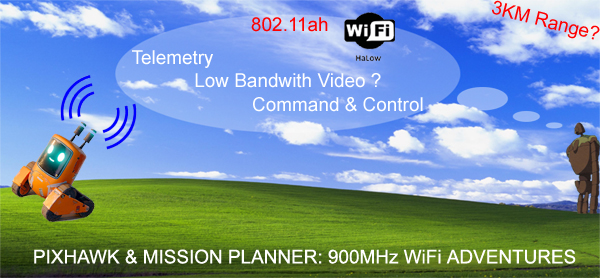Dane.Kouttron
[05.23.21] Long-WiFi: Testing out 802.11ah
| Project
Background |
Chipsets |
HaLow
Modules |
Off the shelf
Hardware |
Range Testing Rover |
Conclusion | Image Directory |
| Some Project Background |
 802.11ah,
or 'WiFi HaLow' is long-range WiFi intended to live in the
ISM [900->930] MHz band (US) and other similar bands
globally. The Wikipedia article for 802.11ah [link] does a
fairly good job of describing what 802.11ah was
intended for, namely 'internet of things'. It supports
some fairly high bandwidth links, so what about rovers? I
like lil-robots running about, so lets see if this can
work for roving snow-bots & autonomous surveying
watercraft. As this is a data / network exercise, for the
sake of clarity I'm just going to write out kilo bytes/second
or kilo bits/second. 802.11ah,
or 'WiFi HaLow' is long-range WiFi intended to live in the
ISM [900->930] MHz band (US) and other similar bands
globally. The Wikipedia article for 802.11ah [link] does a
fairly good job of describing what 802.11ah was
intended for, namely 'internet of things'. It supports
some fairly high bandwidth links, so what about rovers? I
like lil-robots running about, so lets see if this can
work for roving snow-bots & autonomous surveying
watercraft. As this is a data / network exercise, for the
sake of clarity I'm just going to write out kilo bytes/second
or kilo bits/second. The capitalize vs lowercase to indicate either/or is a headache and annoying. |
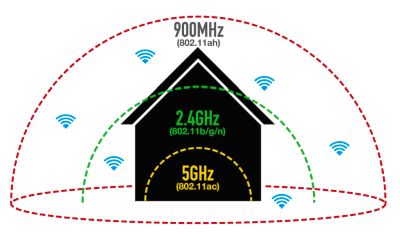 So what's the point of yet another
standard? So what's the point of yet another
standard?This is a surprisingly useful diagram, its basic but it gets the point across. 900mhz is not a great band for super-high data rate activities and you shouldn't expect it to be. A number of things transitioned away from 900mhz / ISM bands just because the antennas were physically bigger. Cordless phones, baby monitors, even r/c toys moved away for the convenience of smaller hardware. 2.4 GHz is just amazing, we can make normal silicon with great sensitivity and its become incredibly cheap. There are however some boundary conditions, 2.4 and 5GHz fundamentally don't really get thru walls & boundaries as effectively while lower frequencies do. You've probably already observed this if you have a dual-band home access point in your residence. 5GHz WiFi not quite reaching your bedroom? Switch to 2.4GHz. But what about outside the home? What about a security camera over by the shed or a weather station over in a tree, or your lawn roomba if iRobot ever gets around to finally making one. 900MHz is the next WiFi, its slower and longer. Can you stream 4k Netflix, no. But what about a sensor-laden rover? |
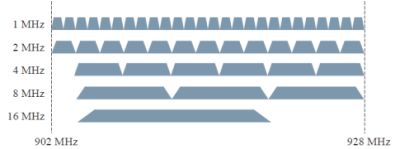 HaLow is very
similar to 802.11ac, but scooted into the 900MHz
band. A good cursory write-up is available in "A
survey on Wi-Fi HaLow technology" [link]. TLDR: there's
1,2,4,8 and 16mhz wide channels, with a completely
ridiculous modulation and coding scheme (MCS) lookup table
[link].
Seriously there is a 234 megabit / second mode
buried in there, is it physically realizable? Probably
not, it requires 16mhz channel mode and some tight timing,
but we're here to see what's possible. HaLow is very
similar to 802.11ac, but scooted into the 900MHz
band. A good cursory write-up is available in "A
survey on Wi-Fi HaLow technology" [link]. TLDR: there's
1,2,4,8 and 16mhz wide channels, with a completely
ridiculous modulation and coding scheme (MCS) lookup table
[link].
Seriously there is a 234 megabit / second mode
buried in there, is it physically realizable? Probably
not, it requires 16mhz channel mode and some tight timing,
but we're here to see what's possible. Nominally the larger the channel the more bandwidth. To be HaLow compliant you need to support at least 1 & 2 MHz channels. There's a convenient plot of what those channels look like on the US band, shown right. |
| Here's a comprehensive list of 802.11ah hardware that I tabulated from digging around for a week, detailed below. |
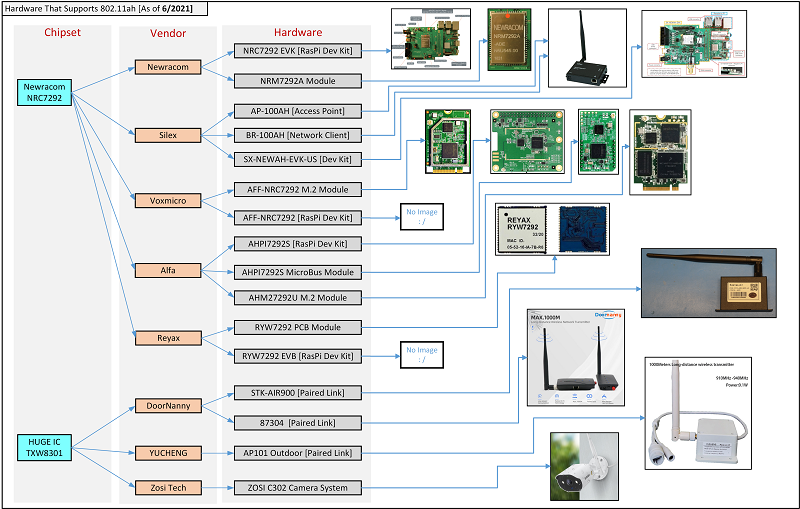 Here is a list of the 802.11ah
landscape as of 6/2021, broken down by chipset and vendor.
We're presently in the middle of a silicon shortage so
access to actual hardware is getting somewhat frustrating.
Most of the items shown are detailed below, the process of
finding each was somewhat curious as some devices just are
not properly advertised as being 802.11ah compliant, while
others simply are too buried to be found. Realistically
though, at the moment, everything is either Newracom based
or HugeIC based, with the large deciding factor
being channel bandwidth of the device, detailed further
below. Here is a list of the 802.11ah
landscape as of 6/2021, broken down by chipset and vendor.
We're presently in the middle of a silicon shortage so
access to actual hardware is getting somewhat frustrating.
Most of the items shown are detailed below, the process of
finding each was somewhat curious as some devices just are
not properly advertised as being 802.11ah compliant, while
others simply are too buried to be found. Realistically
though, at the moment, everything is either Newracom based
or HugeIC based, with the large deciding factor
being channel bandwidth of the device, detailed further
below. For a copy of this Visio file, check here [link] |
Here's the somewhat laborious process:
| Digging in: What chipsets support
802.11ah as of 6-2021? |
 Chipsets are the actual hardware
behind a product. If there are a variety of options, each
product has a different capabilities. In conventional
802.11b/g land there are some chipsets that allow
promiscuous modes, some chipsets that have an impressive
deep-sleep / power save capability, some that are WiFi +
Bluetooth all on the same part. If we can identify the
chipsets we can start to categorize commercial devices.
Given that 802.11ah is relatively new (2018
specification), its likely that developing, testing and
getting through FCC has resulted in only a few offerings.
Lets take a look as to what is available. Chipsets are the actual hardware
behind a product. If there are a variety of options, each
product has a different capabilities. In conventional
802.11b/g land there are some chipsets that allow
promiscuous modes, some chipsets that have an impressive
deep-sleep / power save capability, some that are WiFi +
Bluetooth all on the same part. If we can identify the
chipsets we can start to categorize commercial devices.
Given that 802.11ah is relatively new (2018
specification), its likely that developing, testing and
getting through FCC has resulted in only a few offerings.
Lets take a look as to what is available.Image is a reference, HaLow does not run on potato chips. |
| Newracom
NRC7292 The Newracom NRC7292 appears to be one of the few IC's that passed FCC testing, so a number of assembled products listed below are likely to all be similar in performance and capabilities. Newracom has some information about their chipset here [link]. They have a product brief [link], its a two-page overview. Lets take a look, there's two arm micro controllers (why two?) some power control hardware and communications buses tied around the 802.11ah base band. They have a formal product manual for their sub-module [requires signup here] zyzyzyzyzyyz. The key takeaways are:
Note that this chipset is are available for vendors to purchase and integrate as of the time of this writing [5-2021]. |
HUGE IC: TTLTX-AH-R900ATime for a mystery |
Morse
Micro MM610x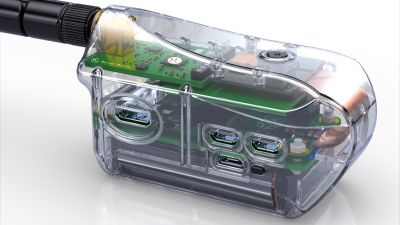 These don't particularly exist yet [as of 5/2021], as of the time of this writing, they have a placeholder page [link], it appears that all of their products will be in the 802.11ah space. I requested more information and will post findings here. Who is Morse Micro? They have a Wikipedia [link] and appear to be really centered around making 802.11ah hardware. They are relatively new, starting in 2016, but I haven't found an actual image of their chip or a Dev-board on their public site. Their twitter [link] is also devoid of any images of their hardware under test, and there are no apparent FCC filings that I could find. Its possible that they have an upcoming release but not really sure when that will happen. There's an article from embedded computing [link] that shows a cad render of some kind of raspberry pi zero with a camera module an off the shelf lithium charger module. Their IC is on a separate daughter card with a right angle SMA. Again this is a cad render, so not really a whole lot we can glean from this. |
| What 802.11ah PCB daughter cards /
modules are available as of 5-2021? |
| NRM7292A The Newracom NRM7292A is a daughter-card / module which contains an NRC7292 and an RF amplifier [RFFM6901]. At the moment this module is only available to specific vendors, and not available to consumers directly. Why a daughter-card? Daughter cards are FCC-able, they have either on-board antennas or a connector for an off-board antenna. Adding an FCC qualified part to your design has two major benefits, namely it has known characteristics & you do not need to fiddle with RF routing. For whatever reason though this one does not, there's no onboard ufl connnector, its just brought out as a pin on a pcb. This is fairly odd. |
| SX-NEWAH Unlike the only available for specific hardware vendors the Silex SX-NEWAH is purchasable off the shelf as a PCB sub-module. Mouser single-quantity prices are $75 [link]. This is nearly identical to the Newracom sub-module, but has a UFL connector for an external antenna. There's no easily accessible datasheet so far, |
| Reyax
RYW7292 yada yada |
| So what 802.11ah hardware exists
as of 5-2021? |
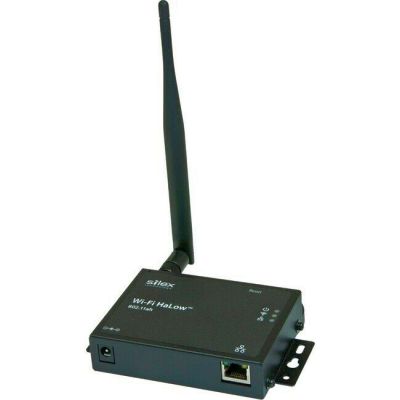 Silex AP-100AH Silex AP-100AHThe first fully enclosed module widget I
found was the Silex AP-100AH listed as literally
the "First Commercial 802.11ah (HaLow) Wireless
Access Point". The AP [link]
takes in 10/100 Ethernet (there is zero reason to have
gigabit on a device that at best will do 30MB/S), claims
a 3km range, 234 simultaneous stations. Here's local
copies of the [Quick
Setup] and [Users
Manual], in case their site changes its links in
the future. Interesting. Lets take a look at the full
manual and see if there are any interesting details. Ok
so some interesting hardware facts:
Its not clear if an AP can be configured as a client
as well. They sell two modules a BR and an AP 100AH,
the BR being used as a bridge? Lets take a look at it
next. Lets take a look at the Silex App-note [link] on this subject to see if there's something else that can be gleaned. Yeah no nothing about how that works, except that to make use of existing Linux features, conventional WIFI channel numbers are correlated with low-band frequencies. That's kind of interesting, and probably makes integration less of a headache. |
| Silex
BR-100AH This module is physically identical to the AP-100AH, it just is the 'client / bridge' version. Not really sure why this isn't just a software / hardware dip-switch. I contacted Silex and got a fairly quick response. From what i can tell both units use the same NRC7292 module internally, and that module can be a client or an access point. Real curious. |
| Silex
SX-NEWAH-EVK-US Ok so this is the dev-kit version, its based around the NRC7292. Some useful specs:23dBm transmit power, -109dBm receive sensitivity. Its available on mouser [link] for $ 212 USD. |
| NRC7292
EVK Ok so this is a vendor who actually makes the module that all of the Silex hardware uses, they are selling an evaluation board [link]. |
Here's an interesting one [link] its similar to the Silex EVK but its reasonably sized. I really like the layout and the price. 54USD? That's 1/4 of the Silex EVK. Its also a reasonable layout, whereas the silex EVK sticks out to the side of the ras-pi. There doesn't appear to be documentation for the module, but i can try and sort that with the vendor. What do the DIP switches do, etc. The Rockland folks seemed really responsive, I checked in weekly to see when this would be in-stock, and the moment it was back in stock they emailed me. Quite good. From the description we get a NRC7292 and a RFFM6901 as the RF amp. So this is super similar to the Newracom module [NRM7292A] detailed above. They have a UFL connector which is great so this thing should be straightforward to do some testing on. It'd be interesting if they went with an SMA/RPSMA as those are generally so much sturdier, but I'm not complaining. Again this daughterboard has an rf shield outline, but doesn't appear to have one installed? A bit odd. Interestingly there are some better screen grabs from ALFA's sight directly [link], Rokland displays version 0A, whereas ALFA shows version 0C. There are some differences, we can spy:
|
| AIRETOS
AFF-NRC7292-NIx M.2 Ok now we're getting interesting, an M.2 802.11ah module [link]. Could this actually be a drop in the same spot as a conventional network card M.2 module? Sneak in a 900mhz antenna in your tablet and you have access to 802.11ah net? Well, that would have been pretty cool, they however do not actually list a manual or a setup guide. I reached out via phone & email, so I guess we shall see. There's not really specs available yet aside from some marketing jargon. Will update whenever they get back to me. The pricing was reasonable for a relatively new technology, $95 USD for the card alone. standard looking UFL connector for an external antenna. This is interesting, as it means adding a modem to a contraption is now relatively small. It'd be great if these were ~$20 but I don't expect that for a while, the price is probably driven by the fact that only one vendor makes 802.11ah qualified chipsets at the moment. |
TX-AH-R900ATR
The module has a users-manual [local copy]
and an FCC test report [local copy].
This is a surprisingly detailed manual
|
The
Ali-Express weirdness begins: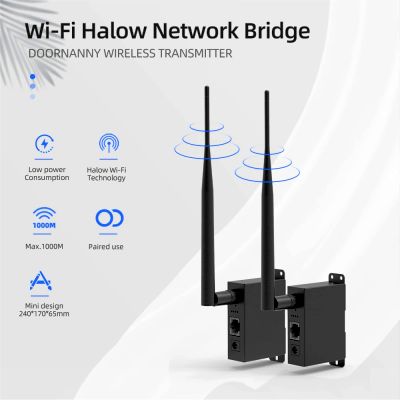 For whatever reason Ali-express has some 802.11ah compatible hardware. They don't claim that in the title, they do however call out some form of "wi-fi HaLow". There are not many yet but there were a few wireless bridges. I ended up ordering a pair that will hopefully arrive some time in the next decade, the particular model is [link], and because alibaba links tend to evaporate, here's a full screen capture [local pdf link]. Its not clear how accurate the specs are but here are some notes:
|
The
Ali-Express weird-links are on Amazon in the states?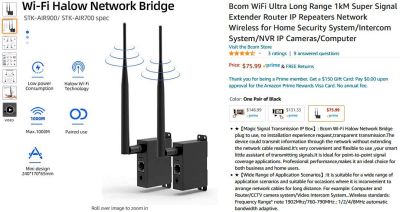 Ok this is interesting. The strange gadgets I found above on Ali-express are hidden away on amazon from one seller. Extra dubiously, the frequency and band it operates on is listed incorrectly as 1902Mhz/760-790MHz. No idea what that is, it should read ~902-926 / 760-790MHz. Probably makes sense to put these next to a frequency plotter before using them. I contacted the seller and he also just regurgitated the above response. I did order the Ali-Express variant, but it wont appear for at least a month, this may be a good look at what these modules are, ahead of time. I'm somewhat surprised they support 8MHz bandwidth, as that would indicate its not NRC7292 based. Given that there is only one other vendor at the moment with an 802.11ah chipset, Its possible this is a HUGE IC TTLTX-AH-R900A based gadget. We do get some useful info from this advert though, its sub-model # is STK-AIR900/ STK-AIR700. That now is way easier to find and reference. |
| Other
variants appear This version [link] was opened up by [twitter]. This one looked even more curious [link]. The internal photograph shows a silk-screened board with lots of debug connection points this is wonderful. |
Is this a joke? you are selling a module that gets integrated into things. OK so next step, lets see if there's any useful information nuggets on the remainder of the FCC filings. |
Alright
here's our list of interesting findings from the FCC:
|
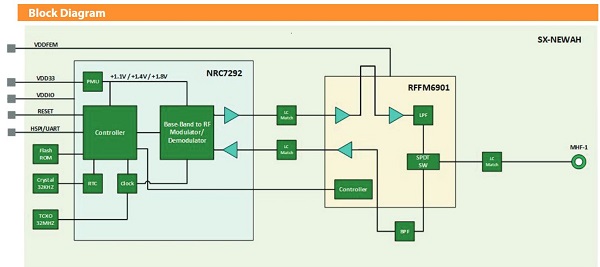 There's two IC's on
that FCC internal photo, whats the other one? There's two IC's on
that FCC internal photo, whats the other one?The second IC is an RFFM6901 according to the block diagram, and the photo. Huzzah, finally something with a formal datasheet [link] [local copy]. Ok lets see what we've got here.
|
| We've
got a new contender, the RYW7292 ! This is an 802.11ah sub-module based again, around the NRC7292. It has a datasheet, an actual datasheet! [link] [local copy] [product page]. So, anything we can glean from it actually gives us hints about the NRC7292.
|
I got in some of these gadgets, lets see how they are constructed
| Teardown: |
| Teardown: |
| Lets do some range-testing and
collect some real-world data |
OK, so we're basically
looking for a few fairly straightforward plots, bandwidth
vs distance with different software & hardware
settings, along with different instruments. Lets make a
list of what we're interested in:
|
| Wait aren't you
intending to use these on rovers, why not just put
everything on a rover Yeah, that is a good idea. I have good ol' strawberry bot [link], which has a 2.4ghz receiver and is basically just an RC buggy at this point. Its unlikely I'd get anywhere near 1km on 2.4ghz, but its possible to get some level of remote-control. I do have a longer-range FrSky 900mhz module but that is highly likely to interfere with 802.11ah testing as it's in the same band. As of recently I've been a fan of my Taranis QX7, its possible that at 2.4ghz with a modern FrSky I'd get better range than the hobby-king TX/RX I was previously using. One note, I'd like to keep the antenna under test fairly high up, while not having a rover that immediately flips over, its possible I may need to add some battery-ballast to the front and back. There may end up being two masts, one for the GPS location and the other for the antenna under test. |
Lets plot an easy way
to range & band-with test. 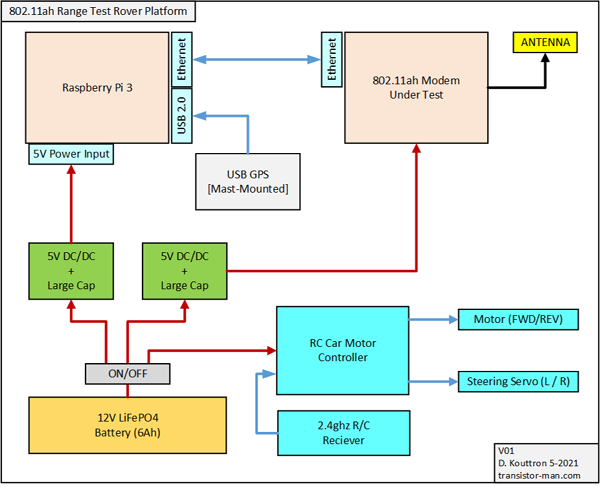 The previous propulsion was
straightforward, a 12v battery, a hobby RC motor
controller, a receiver and that's it, its literally an R/C
buggy. The previous propulsion was
straightforward, a 12v battery, a hobby RC motor
controller, a receiver and that's it, its literally an R/C
buggy. To preform network throughput testing however, that's another story. A few of the device's under test are connected directly over Ethernet, while some are raspberry pi daughter-cards. As a result we should support both. We need power (5V 15W DC/DC supplies), a mast to attach antennas to and a GPS to provide some distance information. I opted for two separate DC/DC's in case the modem under test pulled more power than I anticipated. How are you going to collect data? Good question. My plot was to just ssh from a base-camp laptop to the rover over the 802.11ah connection. I should be able to pull either GPS Lat/Long or write a python script to report back the distance between the base-camp and the rover. To test the bandwidth the easiest way I can think of is host a file on the rover and WGET it to the base station. IPERF is also an option, but its not totally clear which is a better representation of bandwidth. The process would be step-wise and somewhat manual:
|
| Are
these things inter-operable? |
| 802.11ah is a standard,
so if these are standard compliant, can you get an
Ali-Express 802.11ah compliant device to talk to a Silex
Access point? |
| Can
you mesh? |
| Does the 802.11ah
standard support meshing or relay nodes? Can my rover drop
off little pylons/repeaters to add more range at the
expense of latency & bandwidth? |
| What even exists hardware-wise that
supports this standard. |
|
| What the heck is this, 802.11ah network
simulator? https://github.com/asljivo1/802.11ah-ns3 |
|
| https://github.com/droidifi/newracom-s1g |
|
| https://www.futureelectronics.com/p/semiconductors--wireless-rf--rf-modules-solutions--80211-wlan/sx-newah-sp-us-silex-technology-3126392 |
|
| http://www1.futureelectronics.com/doc/Silex%20Technology/Silex-SX-NEWAH-ProductBrief-Updated.pdf |
|
| https://en.wikipedia.org/wiki/IEEE_802.11af |
|
| https://en.wikipedia.org/wiki/IEEE_802.11ah#Products |
|
| https://www.silextechnology.com/connectivity-solutions/embedded-wireless/sx-newah |
|
| https://www.mouser.com/ProductDetail/Silex-Technology/SX-NEWAH-EVK-US?qs=rI7uf1IzohSYrVLdDI6%252BMw%3D%3D |
|
| https://www.mouser.com/ProductDetail/Silex-Technology/SX-NEWAH-EVK-US?qs=%2Fha2pyFaduhClxHcQx61eC%252BCv%2FK7Rvlnz0m%2FAGwau70pQuakUMX6vnbGv0NQ78gU&utm_source=octopart&utm_medium=aggregator&utm_campaign=702-SX-NEWAH-EVK-US&utm_content=Silex%20Technology |
|
| https://www.silextechnology.com/connectivity-solutions/embedded-wireless/sx-newah-evaluation |
|
| https://www.hackster.io/jim-ewing/how-to-set-up-silex-802-11ah-long-range-wi-fi-sx-newah-evk-7c2d38 |
|
| https://store.rokland.com/products/alfa-network-ahpi7292s-ieee-802-11ah-sub-1-ghz-module-in-raspberry-pi-hat-form-factor |
|
| raspi ethernet tutorial https://willhaley.com/blog/raspberry-pi-wifi-ethernet-bridge/ |
|
| sdk for mystery chipset? http://www.zhienchina.com/products/1579.html |
| Taking a quick survey of the
area |
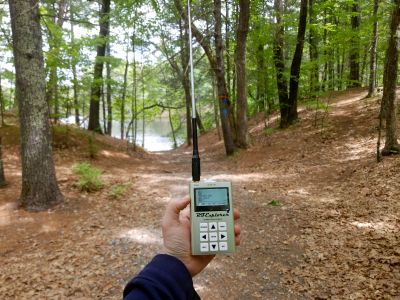 I have this wonderful device, its a
handheld portable spectrum analyzer called the RF Explorer
[link]. I use it normally for
hunting EMF/RFI, but its really wonderful, I think it was
$150 USD at the time of purchase. The part I love? Its
portable and straightforward. The model is listed as just
"RF Explorer" and 50khz -> 960mhz, this model has
been super-seeded by newer variants, which is surprising
as it was manufactured 3/2018. The closest model is the
WSUB1G [link], I have this wonderful device, its a
handheld portable spectrum analyzer called the RF Explorer
[link]. I use it normally for
hunting EMF/RFI, but its really wonderful, I think it was
$150 USD at the time of purchase. The part I love? Its
portable and straightforward. The model is listed as just
"RF Explorer" and 50khz -> 960mhz, this model has
been super-seeded by newer variants, which is surprising
as it was manufactured 3/2018. The closest model is the
WSUB1G [link],
|
| interesting
how to for silex evk |
| Reyax
RYW7292:
http://reyax.com.cn/wp-content/uploads/2020/11/RYW7292_EN.pdf
https://reyax.com/products/ryw7292/ |
| ALFA
module microbus:
https://www.varia-store.com/en/produkt/96031-ahmb7292s-8-ieee-802-11ah-sub-1-ghz-module-with-mikrobus-tm-form-factor.html |
| Alfa raspi
board:
https://store.rokland.com/products/alfa-network-ahpi7292s-ieee-802-11ah-sub-1-ghz-module-in-raspberry-pi-hat-form-factor |
| OK lets make a simple network and see what the
range and speed is. |
|
| In this case we're starting with an access point
and we have one client. The access point has an Ethernet
jack so a normal laptop can be used to diagnose and get
the speed-test vs distance results. The access point |
| With that working, lets make an internet
connected network |
||
Lets start with a known reference point, an
802.11b/g/ac internet connected network with a known
login. We want to do the following:
|
||
| Taking a loo |
|
| Thermal Thoughts | ||
If you have questions or comments, ask below or send over an email.
| Comments: |
|
HTML Comment
Box is loading comments...
|
If you wear a reflective vest very few people ask why you're operating a robot with googley eyes.
Dane.Kouttron
Rensselaer Polytechnic
Institute
Electrical &
Electrical Power
631.978.1650

